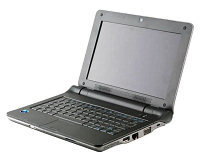VIA presents open source notebook design
Chip manufacturer VIA has presented an open source sub-notebook reference design called OpenBook. CAD files for case components have been made available under the Creative Commons License 3.0 to download from the OpenBook web site. The manufacturer is focusing on OEMs, system integrators, and internet providers who can adapt these designs to their customers' needs. In particular, two modules are available for broadband providers. VIA now offers a board with WiFi, Bluetooth, and optionally assisted GPS (A-GPS) or WiMax, HSDPA and EV-DO/ W-CDMA.

![]() VIA plans to take part in the ongoing boom of low spec notebooks with OpenBook.
The unit has an 8.9in. 1024×600 pixel resolution display, with VIA's mobile C7-M ULV processor inside. The processor has a clock rate ranging from 1.0 to 1.6 GHz and sits on the same board as the VX800 chipset with an integrated Chrome9 graphics unit. The design can support up to 2 GB of DDR2 RAM and save data either on a solid state disk or a conventional hard drive. The OpenBook has three USB 2.0 ports, a VGA socket, Gigabit Ethernet, audio input and output, a card reader, and a two-megapixel webcam. Via says that this sub-notebook will run for up to three hours from a 2600 mAh battery. The ultra-mobile device (UMD) is expected to cost between $500 and $800 – 320 to 510 euros – depending on the configuration, and hit shelves in the third quarter. The PC can run Windows XP, Vista Home Basic, and various Linux distributions.
VIA plans to take part in the ongoing boom of low spec notebooks with OpenBook.
The unit has an 8.9in. 1024×600 pixel resolution display, with VIA's mobile C7-M ULV processor inside. The processor has a clock rate ranging from 1.0 to 1.6 GHz and sits on the same board as the VX800 chipset with an integrated Chrome9 graphics unit. The design can support up to 2 GB of DDR2 RAM and save data either on a solid state disk or a conventional hard drive. The OpenBook has three USB 2.0 ports, a VGA socket, Gigabit Ethernet, audio input and output, a card reader, and a two-megapixel webcam. Via says that this sub-notebook will run for up to three hours from a 2600 mAh battery. The ultra-mobile device (UMD) is expected to cost between $500 and $800 – 320 to 510 euros – depending on the configuration, and hit shelves in the third quarter. The PC can run Windows XP, Vista Home Basic, and various Linux distributions.
With OpenBook, VIA is switching strategy, from a chipset manufacturer for AMD and Intel CPUs, to a provider of low spec PC platforms. Almost a year ago, the Taiwanese manufacturer presented the Nanobook, a design with a 7in. touch screen that was later released as the FIC CE260, to compete – alongside a growing number of other designs– with the EeePC. Two years ago, Intel launched its program for standardised notebook hardware to make it easier for small providers to come up with different configurations based on barebones and main boards.
(trk)
![Kernel Log: Coming in 3.10 (Part 3) [--] Infrastructure](/imgs/43/1/0/4/2/6/7/2/comingin310_4_kicker-4977194bfb0de0d7.png)

![Kernel Log: Coming in 3.10 (Part 3) [--] Infrastructure](/imgs/43/1/0/4/2/3/2/3/comingin310_3_kicker-151cd7b9e9660f05.png)
















